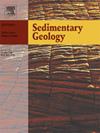Arc-continent collision as recorded in modern stream sand from Oecusse (Timor Island)
IF 2.9
2区 地球科学
Q1 GEOLOGY
引用次数: 0
Abstract
The small territory of Oecusse in Timor Island has extremely complex geology, influenced by the collision of the Australian continent with the Banda Arc. In Oecusse, sedimentary, volcanic and metamorphic units associated with the lower plate Australian continental margin, the upper plate Banda Terrane, and synorogenic sedimentary successions are exposed. In this study, geochemistry, petrography, and heavy-mineral data on fluvial bedload sand transported by first- and second-order streams are used to better understand the status of arc-continent collision in Timor and the geological nature of the terranes involved in this tectonic process. The presence of upper mantle outliers in Oecusse is readily revealed by serpentinite grains, a heavy mineral assemblage with enstatite, olivine and Cr-spinel, and by Cr, Fe, Sc, Ti, and V concentrations comparable to the Primitive Mantle standard. Volcanic sources occur both in the Banda Terrane and Australian continental margin. The Manamas Formation (Miocene, Banda Terrane) is the most prominent volcanic source, shedding detritus dominated by mafic volcanic rock fragments, plagioclase, and clinopyroxene, with a geochemical signature similar to the Primitive Mantle. The volcanic units of the Barique Formation (Eocene-Miocene, Banda Terrane) and the Maubisse Formation (Permian, Australian continental margin) comprise compositionally heterogenous suites and are intercalated with sedimentary successions, delivering more felsic material, as indicated by the diversified assemblages of lithic fragments and heavy-minerals. Geochemically, they are characterised by lower contents of most compatible elements, higher contents of Th, Y and REE, steeper REE profiles, and stronger negative Eu anomaly than Manamas-derived detritus. These petrographic and geochemical features locally reveal a major felsic volcanic component in the Barique Formation, which cannot be related to the ongoing orogeny because of its proposed late Eocene to early Miocene age. With the exception of coastal sectors where the Manamas Formation is widely exposed, volcanic, sedimentary and low-rank meta-sedimentary rocks partially derived from the Australian lower plate tend to prevail, confirming that arc-continent collision is still at an early stage in the western part of Timor Island.
Oecusse(帝汶岛)现代流沙中记录的弧-大陆碰撞
由于澳大利亚大陆与班达弧的碰撞,帝汶岛上的奥库斯小领土具有极其复杂的地质情况。在厄库斯,暴露出与下板块澳大利亚大陆边缘、上板块班达地体和同生沉积序列相关的沉积、火山和变质单元。本研究利用一、二级流搬运的河流层载砂的地球化学、岩石学和重矿物资料,更好地了解了帝汶弧-陆碰撞的状态和参与这一构造过程的地体的地质性质。上地幔异常值的存在很容易通过蛇纹岩颗粒(含顽辉石、橄榄石和Cr尖晶石的重矿物组合)以及与原始地幔标准相当的Cr、Fe、Sc、Ti和V浓度来揭示。火山源出现在班达地体和澳大利亚大陆边缘。马纳马斯组(中新世,班达地系)是最突出的火山源,其碎屑以基性火山岩碎屑、斜长石、斜辉石为主,具有与原始地幔相似的地球化学特征。Barique组(始新世-中新世,班达地系)和Maubisse组(二叠纪,澳大利亚大陆边缘)的火山单元组成成分非均质套,并与沉积序列穿插,提供了更多的长英质物质,这可以从岩石碎片和重矿物的多样化组合中看到。地球化学特征为:大部分相容元素含量较低,Th、Y和REE含量较高,REE剖面较陡,Eu负异常较强。这些岩石学和地球化学特征局部揭示了巴里克组主要的长英质火山成分,由于其形成时间为始新世晚期至中新世早期,因此不能与正在进行的造山运动有关。除麦纳麦斯组广泛露出的沿海段外,多为部分来自澳大利亚下板块的火山岩、沉积岩和低阶变质沉积岩,证实了帝汶岛西部弧陆碰撞仍处于早期阶段。
本文章由计算机程序翻译,如有差异,请以英文原文为准。
求助全文
约1分钟内获得全文
求助全文
来源期刊

Sedimentary Geology
地学-地质学
CiteScore
5.10
自引率
7.10%
发文量
133
审稿时长
32 days
期刊介绍:
Sedimentary Geology is a journal that rapidly publishes high quality, original research and review papers that cover all aspects of sediments and sedimentary rocks at all spatial and temporal scales. Submitted papers must make a significant contribution to the field of study and must place the research in a broad context, so that it is of interest to the diverse, international readership of the journal. Papers that are largely descriptive in nature, of limited scope or local geographical significance, or based on limited data will not be considered for publication.
 求助内容:
求助内容: 应助结果提醒方式:
应助结果提醒方式:


